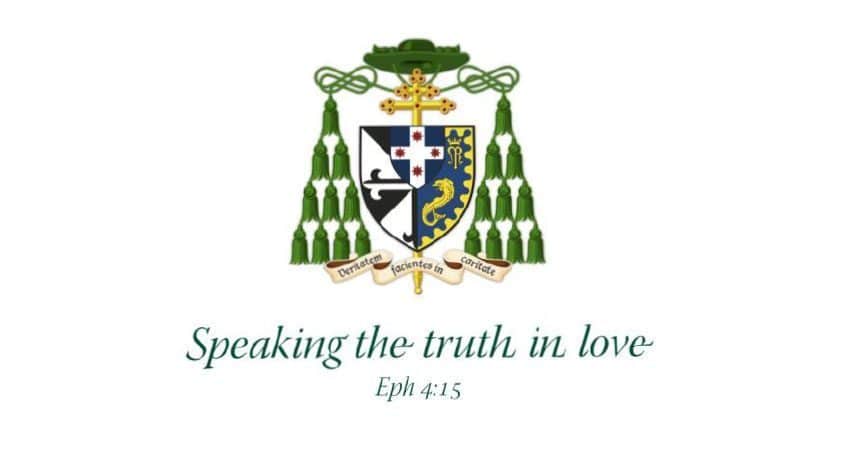HOMILY FOR MASS FOR THE NATIONAL CONFERENCE OF CATHOLIC HEALTH AUSTRALIA

MEMORIAL OF ST MONICA, ST MARY’S CATHEDRAL, SYDNEY, 27 AUGUST 2024

A distraught mother wails inconsolably as the corpse of her son is carried out for burial (Lk 7:11-17). We don’t know the cause of death, age of the deceased, or the family circumstances, but Luke the Beloved Physician is meticulous, as a health professional should be, in his observations and charting. So, we know they are in Nain, a small village on the northwestern slope of Jebel ed-Duchy, 13 km from Nazareth. It commands an extensive view across the plain to Carmel, over the Nazareth Hills, and way past Tabor where the white peak of Hermon glistens in the sun. Luke records that Jesus addressed the deceased as Nεανίσκε (Neaniske), which meant a young man of working age. He is the only child of a widow, which suggests she may have been widowed early and raised him alone. Though she might only be in her late thirties, she now faces an uncertain future, likely lonely and destitute. As mother and townsfolk carry the corpse to the cemetery for burial, Jesus and His disciples encounter grief, fear, anger, incredulity, despair.
Dr Luke reports that when Jesus saw this scene, He ἐσπλαγχνίσθη (esplanchnisthē) which our lectionary translates rather lamely as feeling sorry for or compassionate towards her. The word actually means His bowels churned with visceral empathy. The tears of the poor mother stir Him from the pit of His gut.
Almost four centuries later, the tears of another heartbroken mother would again lead to the revival of another ‘dead’ son. In his famous Confessions, St Augustine records Monica’s incessant badgering of a certain North African bishop to talk to her son Gus, refute his errors and teach him better ways. “Don’t worry yourself,” the bishop said, “boys will be boys, he’s not yet ready to turn from his evil ways, but he’s a thinker and a reader, and eventually he’ll discover how unsatisfying his ways are. Pray for him and be patient.” But like the story of the importunate widow in the same Gospel (Lk 18:1-8), she kept banging at his door until the exasperated bishop was driven to say: “Go away, for it is impossible for the son of so many tears to perish!”[1]
Born in the 4th century in Roman North Africa, Monica had a hard life. Her pagan Roman husband Patricius was unfaithful, abusive and despised her Christian faith. She had little support raising their three children, but she was determined they would be Christians. Unfortunately, her most precocious child, Gus, dumped his faith in his adolescence, dabbling in the esoteric doctrines of Manichean dualists, all the while indulging his passions and fathering a son out of wedlock. Aware that her boy was effectively dead to the Lord, Monica was grief-stricken and for 17 years prayed incessantly that her boy might be led back from apostasy into life with the Lord.
Eventually her prayerful tears were answered. Augustine not only “reverted” to the Christian faith, he lent his immense talents to service of the Church as bishop, theologian and one of the most prolific Christian writers of all time. He penned over five million words, including some of the greatest works ever produced, not only in the Christian tradition but in the entire Western literary canon. And we’d never have had his genius without the unrelenting prayers of his Mum.
Elsewhere in his Confessions, Augustine identifies a parallel between the story of the Widow of Nain and that of his own conversion, claiming that it was Monica’s tears at the thought of her son’s spiritual death that moved God to act. “She carried me forth on the bier of her thoughts, so that you might say to the widow’s son, ‘Young man, I say to you arise!’”[2]
Both the stories of the Nainite Widow and of Monica highlight the immensity of God’s love for us and our part in His work as intercessors. First, God is the divine physician. Throughout His ministry Jesus demonstrated that He was God ready, willing and able to heal people of their physical afflictions[3] and, in the case of Lazarus, Jairus’ daughter and the widow’s son, even to raise them from death.[4]

But the divine physician is not only concerned with our physical health. We are spiritual beings as much as material. We are made in God’s image, animated by His breath, ordered towards ultimate union with Him. As such, we can suffer not only physical death but emotional-spiritual death also. Jesus cautions against thinking physical health is all that matters: “Don’t worry about those who can kill the body so much as about those who can kill both body and soul” (Mt 10:28). So Jesus’ bowels were moved with σπλαγχνίζομαι splagchnizomai-compassion, not just for those suffering disease,[5] but those who were hungry, harassed or helpless, burdened by debt, shame or evil.[6] Many of His healings were spiritual more than physical,[7] or were both, as when He told the cripple lowered through the roof that his sins were forgiven before offering a physical healing.[8] So Monica was right to take her son’s spiritual-psychological health every bit as seriously as his bodily wellbeing. Body and soul, both have their sicknesses, both their remedies.
The best of Catholic health holds these truths together. To care is to care for the other in the fullness of their humanity: body and soul. And this care is modelled on God’s love for the whole person: an active, practical, here-and-now love; a healing and elevating love. The various organisations, institutions and employees under the umbrella of Catholic Health Australia are called to be Christ’s healing hands today saying, “As Christ reached out to touch, console and heal, so do we!” In playing our part in incarnating that Good News in the lives of the sick, frail elderly and dying, we lead our beloved clients to know the God of body and soul, who will one day say to them as He did to the widow’s son and Monica’s also: “I say to you: arise!”
Word of Thanks after Communion at Mass for the National Conference of Catholic Health Australia, 27 August 2024

It’s been a privilege to celebrate this Mass for your annual conference. Recently I had the happy duty of formally closing the Archdiocesan phase of the cause of Eileen O’Connor for beatification and canonisation: it now passes to the authorities in Rome. She was a woman of extraordinary endurance, faith and tenacity, a generous servant of the sick poor while one of them herself, and foundress of an order—the Brown Nurses—to ensure their care. There are so many good stories to tell about Catholic health and aged care in this country, and still so many kinds of service for us to provide. So I pray God will bless your deliberations in the days ahead and on behalf of the Church of Sydney and of Australia I thank you for all that your members do for the sick, frail elderly and dying in our land. May Eileen O’Connor inspire and pray for you at this conference.
[1] Augustine, Confessions, Book III, 12.
[2] Augustine, Confessions, Book VI, 1.
[3] Mt 4:23-24; 8:1-4,14-17; 9:20-22,27-33; 11:5; 12:9-14,22-23; 14:34-36; 15:30-31; 20:29-34; 21:14; Mk 1:29-34,40-45; 3:1-6,10-11; 5:24-34; 6:56; 7:31-37; 8:22-26; 10:46-52; Lk 4:38-41; 5:17-26; 6:6-11; 8:42-48; 11:14; 13:10-17; 14:1-4; 17:11-19; 18:35-43; 22:50-51; Jn 4:46-54; 5:1-9; 9:1-12.
[4] See Mt 9:18-26; Mk 5:21-43; Lk 7:11-18; 8:40-42,49-56; Jn 11:1-44.
[5] Mt 14:14; 20:34; Mk 1:41; Lk 7:13; 10:33.
[6] Mt 9:36; 14:14-21; 15:32; 18:27; Mk 6:34; 8:2; 9:22; Lk 15:20.
[7] Mt 8:28-34; 9:1-8; 15:21-28; 17:14-20; Mk 1:23-28; 2:1-12; 3:10-11; 5:1-20; 7:24-30; 9:14-29; Lk 4:31-36; 5:17-26; 7:36-50; 8:26-39; 9:37-43; 23:39-43.
[8] Lk 5:17-39.
INTRODUCTION TO MASS FOR THE NATIONAL CONFERENCE OF CATHOLIC HEALTH AUSTRALIA – MEMORIAL OF ST MONICA, ST MARY’S CATHEDRAL, SYDNEY, 27 AUGUST 2024
Welcome to St Mary’s Cathedral for our Mass for the National Conference of Catholic Health Australia. I greet all the leaders, management and delegates in attendance who over the next two days will celebrate the significant contributions that Catholic healthcare has made since 1838 and engage on where to next. This year’s conference theme “Rejoice—Reimagine” invites reflection upon how we might continue to serve best those in our hospitals, aged care facilities and community care services.
Today is the memorial of St Monica, who famously appealed relentlessly to the Lord that her bad-boy son Augustine might come back to the faith. Her trust ultimately paid off as tomorrow the Church celebrates the feast of her son, one of the greatest doctors of the Church—not a medical doctor but a bishop-teacher. In her life we see the power of intercessory prayer and the importance of never giving up hope, which qualities should mark all the works of Catholic Health Australia’s members.
Concelebrating with me today are Archbishop Julian Porteous of Hobart who is a CHA director, and Bishop Terry Brady, Emeritus Auxiliary of Sydney and a long friend of CHA. Serving with us is Deacon Michael Tan who is also a GP.
To everyone here today a very warm welcome to you all!

